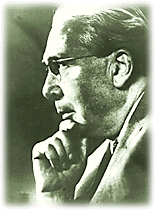|
LEÓ SZILÁRD (1898 - 1964) |
 |
Born in Budapest, Szilárd studied at the Technical Universities of Budapest and Berlin. He was a very versatile individual: physicist and biologist, scientist and inventor, the search for great and comprehensive connections always occupied his mind.
He became a physicist in Berlin under Einstein's and M. Plank's influence, and with Einstein jointly patented the special refrigerator with no rotating parts in 1929.
In England one of Rutherford's lectures aroused his interest in atomic energy. In 1938 he experimented on the splitting of the uranium atom in the United States, and he requested that Enrico Fermi do the same. They arrived at the same solution and both of them realized its military possibilities and dangers if used. Shortly the program to develop the atom bomb was launched. After the attack on Japan, he broke away from research on radioactivity and turned towards biology. He created the new scientific branch of biophysics. Szilárd developed the radiotherapy treatment for cancer, and directed his own therapy when he contracted the disease.
He died in La Jolla, California in 1964.
Fermi-Szilárd nuclear reactor (1955)
The first nuclear chain reaction was launched in 1942. The nuclear reactor produced energy by means of fissioning uranium. The reactor consisted of graphite bricks, which acted as insulating material. The speed of the fission reaction was controlled by a cadmium bar through the reactor.
Enrico Fermi and Leo Szilárd obtained a patent in 1955 for the first nuclear reactor established and commissioned in Chicago, which the government of the United States bought from the inventors for the symbolic sum of one dollar.

